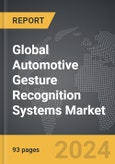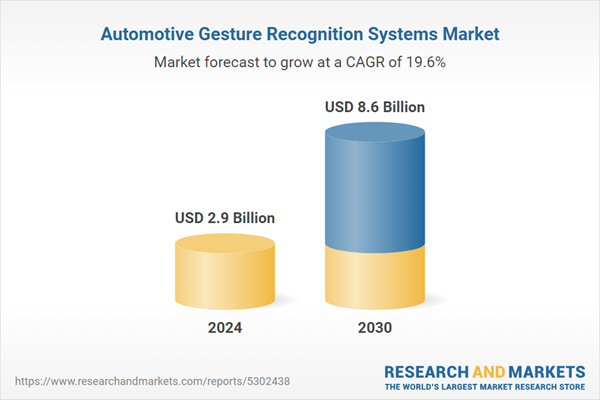The global market for Automotive Gesture Recognition Systems was valued at US$2.9 Billion in 2024 and is projected to reach US$8.6 Billion by 2030, growing at a CAGR of 19.6% from 2024 to 2030. This comprehensive report provides an in-depth analysis of market trends, drivers, and forecasts, helping you make informed business decisions. The report includes the most recent global tariff developments and how they impact the Automotive Gesture Recognition Systems market.
Segments: Authentication Type (Hand / Finger Print / Leg Recognition, Vision / IRIS Recognition, Facial Recognition, Other Authentication Types); Component Type (Touchless Systems, Touch Based Systems); Application (Multimedia / Infotainment / Navigation, Lighting Systems, Other Applications).
Geographic Regions/Countries: World; United States; Canada; Japan; China; Europe (France; Germany; Italy; United Kingdom; and Rest of Europe); Asia-Pacific; Rest of World.
The analysts continuously track trade developments worldwide, drawing insights from leading global economists and over 200 industry and policy institutions, including think tanks, trade organizations, and national economic advisory bodies. This intelligence is integrated into forecasting models to provide timely, data-driven analysis of emerging risks and opportunities.
Global Automotive Gesture Recognition Systems Market - Key Trends and Drivers Summarized
Why Are Automotive Gesture Recognition Systems Becoming Essential in Modern Vehicles?
Automotive gesture recognition systems have emerged as a critical component of modern vehicle interiors, offering a touchless way for drivers to control various functions and interact with the vehicle’s infotainment systems. By allowing drivers to perform simple hand gestures to adjust settings like volume, navigation, and climate control, gesture recognition systems enhance convenience and reduce distractions. This technology aligns with a broader trend toward improving in-cabin user experience and safety, especially in an era where digital interfaces are becoming more sophisticated and multifunctional. Gesture recognition systems help minimize the need for physical controls, making the cabin more streamlined and accessible. As vehicle interiors transform into more technology-driven environments, this touchless control capability reduces driver reliance on traditional buttons and screens, allowing for a more seamless interaction with in-car technology. With safety as a priority, gesture recognition systems are designed to enable drivers to maintain focus on the road, enhancing overall driving safety by reducing the distractions associated with more traditional control interfaces.How Are Technological Advances Shaping the Development of Automotive Gesture Recognition Systems?
Technological advancements in sensors, artificial intelligence, and machine learning have propelled the development of automotive gesture recognition systems, making them more precise and responsive. Early gesture recognition relied on basic infrared or ultrasonic sensors, but today’s systems often use sophisticated cameras, LiDAR, and 3D depth-sensing technologies to detect even subtle hand and finger movements accurately. Machine learning algorithms enable the system to interpret gestures under various lighting conditions and from different angles, increasing reliability and ensuring the system performs well in diverse real-world environments. AI-driven software can learn and adapt to a driver’s unique gestures over time, making the system more intuitive and tailored to individual preferences. With these advanced technologies, gesture recognition systems can now differentiate between intentional gestures and incidental movements, reducing the risk of unintentional commands. As vehicles move toward full autonomy, gesture recognition technology is also expected to support complex functions such as communication with the vehicle’s autonomous systems, signaling instructions, or even managing in-cabin settings when the driver is in an observer role. Together, these technological advancements are enhancing the capabilities of gesture recognition systems, making them a powerful tool in the evolution of the connected car experience.What Role Do Automotive Gesture Recognition Systems Play in Enhancing Safety and User Experience?
Automotive gesture recognition systems significantly enhance both safety and user experience by allowing drivers to control key functions without taking their eyes off the road or their hands from the steering wheel. This touchless control mechanism reduces the need to interact with physical buttons or screens, which can be distracting and increase the risk of accidents. For example, a simple hand gesture can adjust the music volume, change the radio station, or answer a phone call, all while allowing the driver to keep their focus on driving. This feature is particularly beneficial for high-tech infotainment systems that often require complex interactions; by simplifying these interactions, gesture recognition reduces cognitive load on the driver. Additionally, gesture recognition supports customization, allowing users to personalize gestures to suit their preferences, which further enhances convenience. Passenger experience is also improved as gesture controls enable them to interact with certain in-car functions, particularly in luxury vehicles where rear-seat passengers often have access to dedicated screens and controls. The technology plays a critical role in making in-cabin environments safer and more user-friendly, especially as autonomous and semi-autonomous vehicles become more common, where driver and passenger interaction with the vehicle will take on new dimensions.What Is Driving the Growth in the Automotive Gesture Recognition Systems Market?
The growth in the automotive gesture recognition systems market is driven by multiple factors, including advancements in in-cabin technology, consumer demand for enhanced convenience, and the ongoing development of autonomous vehicles. As vehicles become more connected and equipped with sophisticated infotainment systems, consumers are increasingly looking for intuitive, touch-free interfaces that make in-cabin interactions smoother and safer. Gesture recognition offers a unique solution by enabling hands-free operation of complex systems, aligning with consumer expectations for convenience and technological sophistication. The shift toward autonomous vehicles is another major growth driver; in a future where drivers may spend more time engaging with infotainment and work-related features, the ability to control the car through gestures will become even more valuable. Moreover, luxury and premium car manufacturers are actively integrating gesture recognition as a differentiating feature, setting it apart as a mark of innovation and convenience, which is now trickling down to mid-range segments as well. Finally, regulatory focus on reducing distracted driving is encouraging automakers to adopt technologies that keep driver attention on the road, further fueling the adoption of gesture-based systems. Together, these trends point to sustained growth in the automotive gesture recognition market, as the technology continues to evolve and meet the demands of a tech-driven and safety-conscious automotive industry.Report Scope
The report analyzes the Automotive Gesture Recognition Systems market, presented in terms of units. The analysis covers the key segments and geographic regions outlined below.Segments: Authentication Type (Hand / Finger Print / Leg Recognition, Vision / IRIS Recognition, Facial Recognition, Other Authentication Types); Component Type (Touchless Systems, Touch Based Systems); Application (Multimedia / Infotainment / Navigation, Lighting Systems, Other Applications).
Geographic Regions/Countries: World; United States; Canada; Japan; China; Europe (France; Germany; Italy; United Kingdom; and Rest of Europe); Asia-Pacific; Rest of World.
Key Insights:
- Market Growth: Understand the significant growth trajectory of the Hand / Finger Print / Leg Recognition segment, which is expected to reach US$3.4 Billion by 2030 with a CAGR of a 20.3%. The Vision / IRIS Recognition segment is also set to grow at 18.8% CAGR over the analysis period.
- Regional Analysis: Gain insights into the U.S. market, valued at $821.7 Million in 2024, and China, forecasted to grow at an impressive 18.5% CAGR to reach $1.3 Billion by 2030. Discover growth trends in other key regions, including Japan, Canada, Germany, and the Asia-Pacific.
Why You Should Buy This Report:
- Detailed Market Analysis: Access a thorough analysis of the Global Automotive Gesture Recognition Systems Market, covering all major geographic regions and market segments.
- Competitive Insights: Get an overview of the competitive landscape, including the market presence of major players across different geographies.
- Future Trends and Drivers: Understand the key trends and drivers shaping the future of the Global Automotive Gesture Recognition Systems Market.
- Actionable Insights: Benefit from actionable insights that can help you identify new revenue opportunities and make strategic business decisions.
Key Questions Answered:
- How is the Global Automotive Gesture Recognition Systems Market expected to evolve by 2030?
- What are the main drivers and restraints affecting the market?
- Which market segments will grow the most over the forecast period?
- How will market shares for different regions and segments change by 2030?
- Who are the leading players in the market, and what are their prospects?
Report Features:
- Comprehensive Market Data: Independent analysis of annual sales and market forecasts in US$ Million from 2024 to 2030.
- In-Depth Regional Analysis: Detailed insights into key markets, including the U.S., China, Japan, Canada, Europe, Asia-Pacific, Latin America, Middle East, and Africa.
- Company Profiles: Coverage of players such as Cognitec Systems GmbH, Continental AG, Eyesight Technologies Ltd., Harman International Industries, Inc., NXP Semiconductors N.V. and more.
- Complimentary Updates: Receive free report updates for one year to keep you informed of the latest market developments.
Some of the 41 companies featured in this Automotive Gesture Recognition Systems market report include:
- Cognitec Systems GmbH
- Continental AG
- Eyesight Technologies Ltd.
- Harman International Industries, Inc.
- NXP Semiconductors N.V.
- Omek Interactive Ltd.
- Qualcomm Inc.
- Softkinetic Inc.
- Synaptics Incorporated
- Visteon Corp.
Tariff Impact Analysis: Key Insights for 2025
Global tariff negotiations across 180+ countries are reshaping supply chains, costs, and competitiveness. This report reflects the latest developments as of April 2025 and incorporates forward-looking insights into the market outlook.The analysts continuously track trade developments worldwide, drawing insights from leading global economists and over 200 industry and policy institutions, including think tanks, trade organizations, and national economic advisory bodies. This intelligence is integrated into forecasting models to provide timely, data-driven analysis of emerging risks and opportunities.
What’s Included in This Edition:
- Tariff-adjusted market forecasts by region and segment
- Analysis of cost and supply chain implications by sourcing and trade exposure
- Strategic insights into geographic shifts
Buyers receive a free July 2025 update with:
- Finalized tariff impacts and new trade agreement effects
- Updated projections reflecting global sourcing and cost shifts
- Expanded country-specific coverage across the industry
Table of Contents
I. METHODOLOGYII. EXECUTIVE SUMMARY2. FOCUS ON SELECT PLAYERSIII. MARKET ANALYSISCANADAITALYREST OF EUROPEREST OF WORLDIV. COMPETITION
1. MARKET OVERVIEW
3. MARKET TRENDS & DRIVERS
4. GLOBAL MARKET PERSPECTIVE
UNITED STATES
JAPAN
CHINA
EUROPE
FRANCE
GERMANY
UNITED KINGDOM
ASIA-PACIFIC
Companies Mentioned (Partial List)
A selection of companies mentioned in this report includes, but is not limited to:
- Cognitec Systems GmbH
- Continental AG
- Eyesight Technologies Ltd.
- Harman International Industries, Inc.
- NXP Semiconductors N.V.
- Omek Interactive Ltd.
- Qualcomm Inc.
- Softkinetic Inc.
- Synaptics Incorporated
- Visteon Corp.
Table Information
| Report Attribute | Details |
|---|---|
| No. of Pages | 93 |
| Published | April 2025 |
| Forecast Period | 2024 - 2030 |
| Estimated Market Value ( USD | $ 2.9 Billion |
| Forecasted Market Value ( USD | $ 8.6 Billion |
| Compound Annual Growth Rate | 19.6% |
| Regions Covered | Global |









